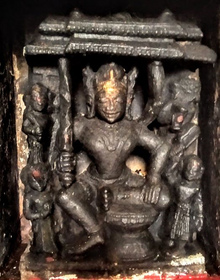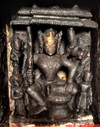|
Gajapati dynasty
The Gajapati dynasty, also called the Suryavamsa dynasty[a][5][6][7] (transl. Solar dynasty)[8] was a medieval Hindu dynasty in the Indian subcontinent, originally from the region of Trikalinga that reigned from c.1434 to 1541. At its peak, it ruled over an empire stretching from the Ganges in the north to the Kaveri in the south, comprising large parts of Andhra Pradesh and some parts of western regions of West Bengal.[9] It succeeded the Eastern Gangas.The Gajapati dynasty was founded by Kapilendra Deva who was of Suryavamsa lineage after the death of the last ruler of Eastern Ganga Dynasty Bhanu Deva IV. Their Capital was Kataka.[10] 20°31′25″N 85°47′17″E / 20.52361°N 85.78806°E The Gajapati kings patronized Vaishnavite Hinduism and were ardent devotees of the God Vishnu. They also commissioned many temples dedicated to the God Vishnu.[11] EtymologyIn Odia, "Gaja" means elephant and "Pati" means master or husband. As such, Gajapati etymologically means a king with an army of elephants or master of elephants. Gajapati was one of the four titles adopted by kings who ruled in pre-colonial era India, the others being Narapati (e.g. Vijayanagara emperors), Aswapati (e.g. the Bahmani sultans), and Chattrapati.[12] HistoryThe region known as Kalinga (present-day Odisha) was ruled by the Eastern Gangas.The early Eastern Gangas ruled from Kalinga-nagara (currently Mukhalingam near Srikakulam, Andhra Pradesh). They shifted their capital to Cuttack in the 13th century. The Hindu philosopher Ramanujacharya had a great influence on the Raja Choda Ganga Deva, who renovated the temple at Puri. Narasingha Deva I built the Sun Temple at Konark and Varaha Lakshmi Narasimha temple, Simhachalam at Visakhapatnam. The Gangas were succeeded by the Gajapati monarchs. Two copper plates of the early Pallava dynasty have been found in the Kolleru Lake, traced to Gajapati Langula Narasimha Deva, an Oriya ruler (Odia Raja). According to legend, the Gajapati fort was located at Kolleti Kota on one of the eastern islands of the lake, which protected the Odia forces. The enemy general encamped at Chiguru Kota located on the shores and tried to excavate a channel in the modern-day Upputeru, so that the water of the lake would empty into the sea and allow an attack on the Gajapati fort.[10]  The Gajapatis at the height of their power in the 15th century, ruled over an empire extending from the Ganges in the north near Hoogly to the Kaveri in the south under the Emperor Kapilendra Deva.[5] But by the early 16th century, the Gajapatis lost great portions of their southern dominion to the Vijayanagara Empire and the Turko-Persian Golconda Sultanate.[13] This period was marked by the influence of Chaitanya Mahaprabhu and by the expansion of Jagannath temple across the length and breadth of the empire. One of the causes of the reduction in militarism among the population has been attested to the Bhakti movement initiated by Sri Chaitanya Mahaprabhu, who arrived in the empire during the reign of Emperor Prataparudra and stayed for 18 long years at Puri.[6] Emperor Prataparudra was highly influenced by the works of Chaitanya Mahaprabhu and gave up the military tradition of the Kalinga emperors.[14] He retired to the life of an ascetic leaving the future of the empire uncertain. Govinda Vidyadhara took the opportunity to assassinate the sons of the emperor and usurped the throne for himself.[13] Gajapati militaryThe records of the Suryavamsi Gajapatis gives a picture of their military administration which they had inherited from the Eastern Gangas rulers. The Gangas had a vast and well-organised military which was improved upon by Kapilendra Deva. The empire was built on the lines of a military state, with the protection of the state and its expansion being the responsibilities of the state and population. Militarism had penetrated into different ranks of the society and the Emperor had a large standing army which included a large number of soldiers and local-militants in the standing army. Besides the feudal tributary states of the Gajapatis also provided a stipulated number of soldiers at the time of war and had to fight for the Gajapati in the battle field.[15] Military titlesSome of the military titles include:[16]
Gajapati military divisions The Odia poet Sarala Das who lived during the reign of Kapilendra Deva, has given descriptions about the military divisions in his Odia Mahabharata.[16] The divisions mentioned are:
Gajapati Infantry units The infantry units of the Gajapati military are as follows:[16]
Military instruments and weaponsMusical instruments used to motivate soldiers during march and warfare. The names of musical instruments include Damalu, Damame, Tamaka, Bizighosa, Daundi, Ghumura, Bheri, Turi, Ranasingha etc. The names of weapons used by the Gajapati army are also mentioned like Dhanu, Trona, Sara, Asi, Parigha, Pattisa, Kunta, Jathi, Buruja, Saveli etc. Information with regards to breaking of gateways and walls of forts with the help of horses, elephants and iron instruments are also found in the same text.[16] Contemporary sourcesOther contemporary sources also reveal details on characteristics of the Gajapati military. Muslim texts like Buhan-m-Mansir give accounts of the Emperor Kapilendra Deva having an elephantry numbering two hundred thousand. Such a large number of war elephants is highly unusual even when compared with any contemporary military of the existing kingdoms during the times of Kapilendra Deva himself, in India.[citation needed] Nizzamuddin writes that the Gajapati encamped on the banks of the river Godavari with an infantry of seven hundred thousand. Fernão Nunes, the Portuguese-Jewish traveler who spent three years at Vijayanagara, the capital of the Vijayanagara Empire estimates size of the army of Emperor Prataparudra to the extent of 13,000 elephants, 20,000 horses, while fighting against the Vijayanagara Empire and also notes that the Odia soldiers were excellent fighters. Rayavachakamu also gives interesting accounts about the feats and exercises practised by the Gajapati soldiers at their capital Cuttack.[17] DescendantsTalcher branchDuring the reign of the Emperor Purushottama Deva, the overlordship of Bhimanagari was established in 1471 CE by Narahari Singh who was a scion of the family of the ruling Suryavamshi Gajapati kings. Later in 1578, under the reign of Padmanabha Birabara Harichandan, the kingdom was renamed as Talcher in the honor of their family goddess Taleshwari.[18][19] The kingdom acceded to India and merged into the state of Odisha following independence in 1947. List of rulers
Culture  The Gajapatis are devout worshipper of Lord vishnu patronized Vaishnavite Hinduism and expanded the Jagannath temple at Puri. The Jagannath temple became the center for an efflorescence of drama and dance (Odissi) and other forms of art during Gajapati rule.[21] During the rule of Kapilendra Deva construction of the Shaivite Hindu Kapilesvara Temple in Bhubaneswar is done.The Narendra tank in the Puri Jagannath temple premises was constructed by Kapilendra Deva where the Chandan Jatra festival of Lord Jagannath takes place.[11][5][10] The Gajapatis believed themselves as the servants of Lord Jagannath and start their mornings with their worship and blessings.[5] Gallery
See alsoNotesReferences
Bibliography
|
|||||||||||||||||||||||||||||||||||||||||||||||||||||||||||||||||||||||||||||||||||
![The dynasty's greatest extent under Kapilendra Deva, with briefly held territories in a lighter colour and dashed border[1]](http://upload.wikimedia.org/wikipedia/commons/thumb/8/8c/Map_of_the_Gajapatis.png/300px-Map_of_the_Gajapatis.png)







